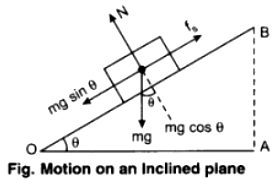Motion on an Inclined Plane
Consider an inclined plane as shown in the figure that makes an angle 0 with the horizontal plane OA Assume an object of mass m moving on this plane. Initially, let us suppose that the object does not move due to friction. Various forces act on the object.
(i) Weight of the object, W = mg
(ii) Normal reaction, N
(iii) Frictional force, fs
In the vertical direction, there is no acceleration. Balancing the components of weight, W = mg,

mg sinθ = fs …………. (1)
and, mg cosθ = N …………. (2)
Now, if we move the plane OB upwards so that 0 increases, then at a position, the object will start moving on the inclined plane OR At this position
(fs)max = μsN
Where, μs is the coefficient of static friction between the object and the plane. In this position, let θ = θs (maximum value of the angle) and (fs)max are placed in the above expressions,
mg sinθs = μsN
mg cosθs = N
From above equations,
tanθs = μs ……….. (3)
From equation (3), we can determine the coefficient of static friction between the inclined plane and the surface of the object.
When the value of θ is slightly more than θs, then a small net force acts on the object and object starts to slide. We further increase the value of θ so that the object moves downward with accelerated motion.
Then, we keep on decreasing the value of θ so that the object moves with a constant velocity at θ = θk,. At this position, kinetic frictional force acts on the object.
Substituting fk in place of fs, μk in place of μs and θk in place of θs in equation (1 & 2), we get the following equations :
mg sinθk = fk ………….. (4)
mg cosθk = N ………….. (5)
Again, putting fk = μkN in above expressions,
tanθk = μk ……………. (6)
From equation (6), we can determine the coefficient of kinetic friction between the inclined plane and the surface of the object.
Knowing the distances of the horizontal plane OA and inclined plane OR we can find tanθs and tanθk using the relation, tanθ = \(\frac{A B}{O A}=\frac{\sqrt{O B^{2}-O A^{2}}}{O A}\) this way, we can find out the coefficient of friction.
Note that BA is perpendicular to OA.